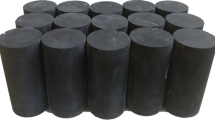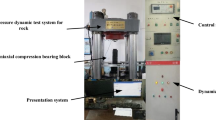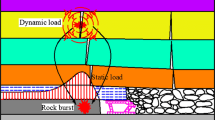Abstract
To investigate the influence of gas pressure on rock burst proneness of coal, the rock burst proneness tests were conducted under different gas pressures. Based on the energy method, the rock burst proneness and energy accumulation law are analyzed. The following conclusions can be drawn: (1) The change laws of impact energy index, the effective impact energy index and the residual energy index are consistent, reducing with the increase of gas pressure. (2) Before the coal failure, the total energy, the elastic energy, and the dissipated energy of coal specimens increase with the increase of the stress. The increase speed of total energy is the fastest, the elastic energy takes the second place, and the dissipated energy is the slowest. (3) The failure energy ratio and stress drop coefficient defined by energy can be used to describe the rock burst proneness. (4) The failure modes of coal samples transform from brittle failure into ductile shear failure with the increase of gas pressure. (5) In the coal seam which has typical dynamic hazards, there is a critical value of gas pressure. When the gas pressure is higher than the critical value, gas outburst is the main disaster. When the gas pressure is lower than the critical value, the rock burst is the main disaster.










Similar content being viewed by others
References
Bukowska M (2013) Post-peak failure modulus in problems of mining geo-mechanics. J Min Sci 49(5):731–740
Chen XH, Li WQ, Yan XY (2012) Analysis on rock burst danger when fully-mechanized caving coal face passed fault with deep mining. Saf Sci 50(4):645–648
Connell LD (2009) Coupled flow and geomechanical processes during gas production from coal seams. Int J Coal Geol 79(1):18–28
He MC, Miao JL, Feng JL (2010) Rock burst process of limestone and its acoustic emission characteristics under true-triaxial unloading conditions. Int J Rock Mech Min Sci 47(2):286–298
Jiránková E (2010) Assessment of rigid overlying strata failure in face mining. Central Eur J Geosci 2(4):524–530
Kabiesz J (2006) Effect of the form of data on the quality of mine tremors hazard forecasting using neural networks. Geotech Geol Eng 24(5):1131–1147
Konicek P, Soucek K, Stas L, Singh R (2013) Long-hole destress blasting for rockburst control during deep underground coal mining. Int J Rock Mech Min Sci 61:141–153
Li T, Cai MF, Wang JA, Li DC, Liu J (2005) Discussion on relativity between rockburst and gas in deep exploitation. J China Coal Soc 30(5):562–567
Mazaira A, Konicek P (2015) Intense rockburst impacts in deep underground constructions and their prevention. Can Geotech J 52(10):1426–1439
Mutke G, Dubiński J, Lurka A (2015) New criteria to assess seismic and rock burst hazard in coal mines. Arch Min Sci 60(3):743–760
Peng R, Ju Y, Wang JG, Xie H, Gao F, Mao L (2015) Energy dissipation and release during coal failure under conventional triaxial compression. Rock Mech Rock Eng 48(2):509–526
Professional Standards Compilation Group of People’s Republic of China. Classification and laboratory test method on bursting liability of coal (GT/T25217.2–2010). Beijing, Standards Press of China, 2010
Song DZ, Wang EY, Liu ZT, Liu XF, Shen RX (2014) Numerical simulation of rock–burst relief and prevention by water–jet cutting. Int J Rock Mech Min Sci 70:318–331
Song ZL, Han PB, Li WP, Yin GZ, Li MH, Kang XT (2015) Impact of energy dissipation of coal samples with rockburst tendency from gas in its failure process. J China Coal Soc 40(4):843–849
Su CD, Yuan RF, Zhai XX (2013) Experimental research on bursting liability index of coal samples of Chengjiao mine. Chin J Rock Mech Eng 32(S2):3696–3704
Wang Z, Yin GZ, Hu QT, Jin HW (2010) Inducing and transforming conditions from rockburst to coal–gas outburst in a high gassy coal seam. J Min Safety Eng 27(4):572–575
Xia TQ, Zhou FB, Liu J, Kang JH, Gao F (2014) A fully coupled hydro-thermo-mechanical model for the spontaneous combustion of underground coal seams. Fuel 125:106–115
Xia T, Wang X, Zhou F, Kang J, Liu J, Gao F (2015) Evolution of coal self-heating processes in longwall gob areas. Int J Heat Mass Transf 86:861–868
Xie HP, Li L, Peng R, Ju Y (2009) Energy analysis and criteria for structural failure of rocks. J Rock Mech Geotech Eng 1(1):11–20
Xu GA, Niu SJ, Jing HW, Yang SQ, Wang WL (2011) Experimental study of energy features of sandstone under loading and unloading. Rock Soil Mech 32(12):3611–3617
Xue S, Yuan L, Xie J, Wang Y (2014) Advances in gas content based on outburst control technology in Huainan, China. Int J Min Sci Technol 24(3):385–389
Yan P, Zhao ZG, Lu WB, Fan Y, Chen XR, Shan ZG (2015) Mitigation of rock burst events by blasting techniques during deep-tunnel excavation. Eng Geol 188:126–136
Zhang ZZ, Gao F, Liu ZJ (2010) Research on rockbursts proneness and its microcosmic mechanism of granite considering temperature effect. Chin J Rock Mech Eng 29(8):1591–1602
Zheng H, Liu DF, Lee CF, Ge XR (2005) Principle of analysis of brittle–plastic rock mass. Int J Solids Struct 42(1):139–158
Acknowledgments
The authors are grateful to the financial support from the National Natural Science Foundation of China (51404250), the Natural Science Foundation of Jiangsu, China (BK20140189), the China Postdoctoral Science Foundation (2014M550315) and the College Graduate Research and Innovation Program of Jiangsu Province (KYLX15_1408).
Author information
Authors and Affiliations
Corresponding author
Rights and permissions
About this article
Cite this article
Xue, Y., Gao, F., Teng, T. et al. Effect of Gas Pressure on Rock Burst Proneness Indexes and Energy Dissipation of Coal Samples. Geotech Geol Eng 34, 1737–1748 (2016). https://doi.org/10.1007/s10706-016-9985-x
Received:
Accepted:
Published:
Issue Date:
DOI: https://doi.org/10.1007/s10706-016-9985-x




